|
Unlike the English Premier League, this blog is taking a winter break until Monday 6th January 2014. We would like to wish our readers seasonal greetings and best wishes for 2014.
By John Considine The weeks leading up to Christmas are critical for publishers and booksellers. More than 70% of book sales by volume take place in the last quarter of the year. It can be even more important for sports books with up to 85% of the sales coming in the same period. 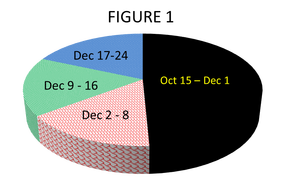 According to Fergal Tobin (Gill & Macmillan) the typical sales-cycle of a sports book involves publication from early September to about the third week of October. Any later than that and the sales window on the run in to Christmas begins to close. The launch is usually accompanied by press-releases and other promotional activity. These activities are compressed, if possible, into a period of a week or two following first publication for maximum media effect. This is important no so much in immediate sales terms as in establishing the book in the public consciousness. And you only get a week or so, for next week someone else’s book will be clamouring for attention. This year Gill & Macmillan published a book on the economics of the GAA. GAAconomicsis not a traditional sports book but its sales-cycle can be expected to have a similar pattern. The book was launched on October 15th. The most up-to-date figures suggest the distribution of sales as in Figure 1. The importance of the last three weeks of sales are crucial (the last two weeks figures are estimates based on current sales). Gill & Macmillan has a record of publishing sports books with an Irish interest. The company has published books on the Irish journey in Italia 90, the Irish winners of golf’s major tournaments, and on Ireland’s 2012 Olympic medal winner Katie Taylor. It has also publishes books on gaelic games. Hurling is covered in books by authors like Seamus King, Michael Moynihan and Gavin Mortimer. Mortimer has written an “ultimate guide” to hurling and a second book with a similar title on gaelic football. Other gaelic football books in the Gill & Macmillan stable include Deadlocked by Eoghan Corry and A Parish Far From Home by Philip O’Connor. These books can be accessed here. By Robbie Butler Here’s a quick look at some referee statistics from the 2012-2013 Premier League season. The table below presents data on the average number of yellow cards distributed per games by the sixteen Premier League referees. The data covers 373 games last season, excluding the games refereed by referees Roger East (5), Robert Madley (1) and Craig Pawson (1).  The referee most likely to produce a yellow card last season was Martin Atkinson, who brandished a total of 94 yellows across 25 league games. The most lenient referee, according to this data, was 51 year old Chris Foy. The St. Helens native dished out just 2.14 yellows per games. He was closely followed by the oldest Premier League referee, Mark Halsey, whose average was 2.17 yellow cards per game. It’s interesting that the two oldest referees in the league are found to be the most lenient. Maybe this is because they have mellowed in their ‘old age’ or believe they command the respect of players, without requiring enforcement. What’s even more interesting is that the 3rd and 4th most lenient referees are the two youngest; Michael Oliver (28) and Anthony Taylor (35). This suggests a non-linear effect is at play. Maybe younger referees are less likely to book players out of inexperience, whilst older refs could feel they can control the game without the need for additional punishment. The plot thickens. By Ed Valentine It’s very hard to get into Formula 1 and it’s even harder to stay there. There are only 22 men in the world that can claim to be an F1 driver during any given season. However, the scarcity power is with the teams and not with the drivers as the business model for mid and lower grid teams has a pay as you go contract system. It’s a mechanism which is akin to an average footballer at an average Premier League team, say Scott Parker, having to find €5 million of sponsorship money to gain a place in the Fulham squad. It would certainly avoid a repeat of a Winston Bogarde situation but realistically would never happen in top flight football. It has been common practice in F1 for years. Our very own Eddie Jordan signed Michael Schumacher and gave him his F1 debut in 1991 over more experienced drivers because the German’s $150,000 in sponsorship money was too good an offer for the Irish team to turn down. 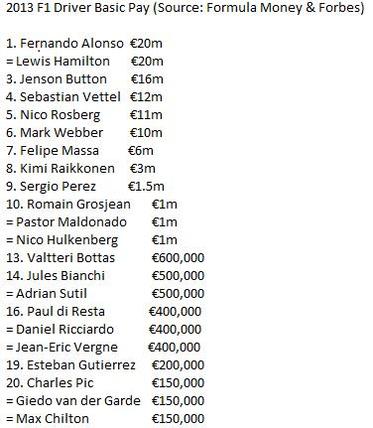 The drivers of the top 4-5 teams in the championship will generally command huge salaries as can be seen in the table beside. The top 9 drivers on the list will have had a large amount of bargaining power with their agents pushing to get the highest salaries possible before putting pen to paper. But for the drivers below there is a different approach entirely. The race seats at the mid to back of the grid will be auctioned off to the highest bidder i.e. the driver who can bring the most sponsorship money to the table. It isn’t a question of being quick enough for F1 it’s more about being rich enough or having the wealthiest sponsorship backing. Pastor Maldonado, who scored just 1 point in 2013, managed to bring $8 million in Venezuelan government oil sponsorship to the Williams F1 team (the driver receiving $1million of that as salary). Without that cash it would have been difficult for the team to keep its doors open. Liquidity is becoming a problem that is racing its way through the grid at an alarming rate. As previously mentioned in an earlier article there are mechanisms in place to ensure no F1 will get into debt, however, to enable a stable liquidity flow a lower ranked team may opt to compromise on out and out speed by selling its seats for anything between $5-8 million rather than selecting the most talented available driver. The end result is that the overall product to fans, F1 being a spectator driven sport, is of a lower quality. It will create a talent bottle neck in about 5 years ’time when the most experienced drivers in F1 will have spent the large part of their careers as payers rather than payees who were not necessarily the best of their generation. One solution is for teams at the back end to receive a parachute payment similar to the NFL draft which gives the lowest placed squad the first pick of emerging talent for the next season. If the FIA are looking to keep the grid populated and help finances then the bottom five F1 outfits could be given a prize fund which enables them to buy the best of new driver talent rather than selling a contract to the highest bidder. Until this takes place a quick driver will be worth maybe a tenth of a second over a rival but a wealthy driver truly is worth his weight in gold.  By Robbie Butler In a recent ITV documentary Keane & Vieira: The Best of Enemies, Roy Keane and Patrick Vieira take time out to discuss the epic battles between Manchester United and Arsenal from 1996 to 2005. Both men were steadfast in the belief that their team had emerged victorious from the long running feud between the two clubs, which started following the arrival of Arsene Wenger to the Premier League in 1996. What was interesting about the Keane/Vieira conversation was the belief that both men held regarding referee favouritism. Keane argued that Arsenal were always given the benefit of the doubt in home games, while Vieira claimed United were always treated differently by referees, almost suggesting that United were clearly 'liked' by certain officials. All football fans probably get the feeling that the ‘other’ team gets more decisions from the referee. Most non-United fans would claim the Red Devils are always in receipt of ‘kind’ decisions, while Man United fans will argue that opposite and claim, like David Moyes did with the fixture list this season, that others are ‘out to get’ the league champions. A raft of literature exists on the extent of referee bias in football (for further works see here, here and here). The examination of referee decision-making has ranged from the likelihood of a referee awarding a penalty to a visiting team, to the probability of a referee being more susceptible to influence from home supporters located in closer proximate to the playing pitch. With this in mind, I have collected data on one variable where refereeing bias could exist, the allocation of injury time, for all 380 games in the 2012-2013 Premier League season when a team is winning, drawing and losing home games. In addition, I have data on the number of substitutes, yellow and red cards, attendance and referee, which form the body of a working paper (to follow). The data presented in the first scatter plot below shows the number of seconds of added time (X-axis) for each team when losing a home game and their finishing league position. This is when extra added time is beneficial to the home team. No bias can be observed towards the big clubs. In fact, while Liverpool and Everton do very well, Manchester City and Chelsea are among the least favoured. The second scatter plots presents data for 267 games last season when games were tied or just one goal separated the teams as the game entered added time. Again no bias is evident towards the top four clubs with Manchester United, Chelsea, Arsenal and Manchester City in particular all at the lower end of the scatter plot. Liverpool have little to complain about as they get the most time when losing at home. It appears when it comes to the allocation of added time, Premier League referees are highly impartial. More to follow...
By John Considine In a previous post I looked forward to the release of the report on which Minister Varadkar sought government support for a 2023 RWC bid by Ireland. Now it seems that the report will not be released to the public. It is disappointing that taxpayers cannot get access to the report.
I emailed the Minister’s office asking for a copy of the report. The reply pointed out the report was commissioned by the IRFU and, as a result, the Minister would not give me the report. Therefore, I emailed the IRFU. They also told me they will not release the report. With remarkable timing after yesterday's post on stadium naming rights and tradition in sport by John Considine, it is reported today that Barcelona have agreed to a deal with Intel to have the chip-maker's logo on the inside of their players' shirts. The positioning is not just a play on the Intel slogan but will, according to media accounts, be strategically placed to be seen if and when players put their shirts over their heads in a traditional goal celebration.
It is notable that this deal involves Barcelona, a club that for so long refused to have sponsorship on their shirts. In 2006 they agreed to put UNICEF's logo on their shirts. Their first commercial sponsorship was not until the 2011/12 season when Qatar Sports Investments, which saw Qatar Foundation on their shirts for two seasons followed by Qatar Airways this year. For comparison, Manchester United's first sponsor, Sharp, appeared in 1982/3, Liverpool (the first professional club) had Hitachi in 1979 and Real Madrid started with Zanussi in 1982/3. By John Considine At the weekend, Everton’s Gerard Deulofeu scored an equaliser to stop Arsenal going seven points clear at the top of the Premier League. Deulofeu is on loan at Everton from Barcelona. After the game, his manager Roberto Martinez, said the player was benefitting from the different refereeing culture in English football. Martinez claimed that Deulofeu was learning that one cannot always look to the referee for assistance. 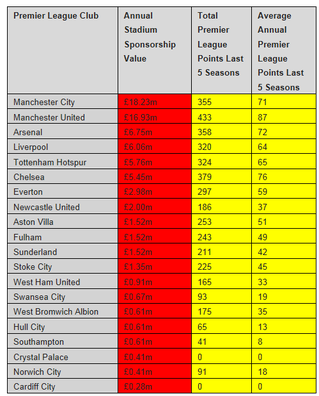 Cultural differences also seem to be surfacing off the field in the Premier League. In the last couple of days, Assem Allam applied to change the name of the Premier League team Hull City to Hull Tigers (here). Opponents have a point when they say that Allam does not understand the culture of the club or the game. However, these opponents might not realise how quickly that culture can change. It was only in the late 1970s that professional clubs like Liverpool started to change the culture of English football when it came to putting sponsors names on team shirts. Almost overnight it became accepted practice. To see the differences in cultures one need only look at the naming of sporting stadiums. At the start of this month, American Appraisal (a company focused on valuation-related advisory services) released their estimates of the potential value of stadium naming rights in the Premier League. Their estimates are provided in the table in this blog post. Their analysis is well worth reading and is available here. It is appropriate that a company with “America” in the title should provide the estimates of the stadium naming rights. Like so many other innovations is the business of sport, American has led the way. The American experience also shows how quickly things change. Michael Sandel says that in 1988 “only three sports stadiums had naming rights deals worth a total of $25 million” (here). Over the next 15 years things changed dramatically. He says that by 2004 “there were sixty-six deals, worth a total of $3.6 billion”. Will the dominance of American sporting culture wash out the difference in stadium naming traditions in Europe? If it does then what will be lost? On a rough approximation, the grounds of English Premier League clubs tend to have a geography element – in the same way as the clubs have a geography element in their title. Words like “road”, “lane”, and “park” feature in the stadium names. Many fans do not want to lose these names. Change has occurred slowly so far - although some clubs have taken the opportunity of a move to a new stadium to introduce naming rights deals. Arsenal moved from Highbury to the Emirates Stadium. Manchester City moved from Maine Road to the City of Manchester Stadium before renaming it the Etihad Stadium. In Ireland, GAA grounds tend to have the names of culturally significant people. The names of early patrons of the GAA such as “Croke” and “Cusack” feature prominently. Cork county teams play in two stadia that carry the names of two of the county's more famous sons. One stadium is named after the legendary hurler Christy Ring. The main stadium is named after Padraig O Caoimh who was General Secretary of the GAA for 35 years in the middle of the 20th century. Significantly, these stadia carry the Irish language version of the names. It would be a pity if all of these cultural differences were lost. Cultural differences have an important place in sport. Off the field they can help fans identify with the team and with the game itself. On the field, they can help the development of players like Gerard Deulofeu. In the context of the current debate about the salaries and "top-up" payments, Professor Brian Lucey (Trinity College Dublin) highlights the €105,835 paid to the Press Advisor to the Minister for Transport, Tourism and Sport (here). Professor Lucey says "lets not cut funds to the CRC when we are paying the press advisor for the minister for sport over 100k PA".
By Robbie Butler & David Butler Manchester United fans are probably starting to understand what it’s like to be a supporter of any other club. Back-to-back home defeats at Old Trafford in the Premier League have left many fans questioning what is to come this season and what can and can’t be achieved in the years ahead. While even the most partisan of fans will struggle to defend a position of a successful title defence, many fans are now starting to wonder about a top four place. Of course, it’s impossible to know precisely what will happen in the months ahead, but we’ve complied some data to give fans an idea of what might be in store for David Moyes' team based on previous years. The race for '4th spot' has existed since 2002 when English teams were offered an additional Champions League place by UEFA (via a qualification route). Since then the average number of points required for 4th place has been 70 (See here). However, since 2008 the standard has risen slightly, with 71.33 points required for what is usually the last Champions League spot. With United currently on 22 points, the Red Devils need to capture 2.15 points per game from here to May, in order to hit the magic 70 point mark. That's roughly seven wins from every ten games. Having lost five games so far the omens don’t look good. Since 2007, no team has lost more than 10 games and finished inside the top 4 places. Mind you, Newcastle lost 11 games and finished 3rd in 2003 while Everton lost a 13 (that's one-third of all league games!) and still beat Liverpool to 4th spot in 2005. However, 61 points was enough for 4th that year; the second lowest total ever. An increasingly competitive Premier League since 2008, thanks to the performances of Tottenham and Manchester City, suggest that stats since 2008 are probably the best guide to what lies ahead for Manchester United. The table below shows the number of games the 4th placed team has lost and points accumulated from 2008 to 2013. 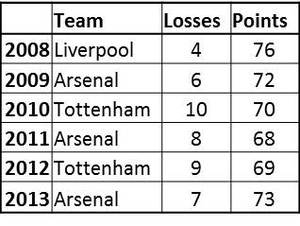 The mean number of losses since 2008 has been 7. This has the current champions under serious pressure. Assuming a best case scenario, they can probably afford to lose another five games. Here are the fixtures that Manchester United still have to play against teams currently ranked above them in the Premier League, that could be a source of potential losses: Home to Tottenham (Jan 1st), Away to Chelsea (Jan 19th), Away to Arsenal (Feb 11th), Home to Man City (March 1st), Home to Liverpool (March 15th), Away to Newcastle (April 5th), Away to Everton (April 19th), Away to Southampton (May 11th). This is not to mention other 'surprise' defeats that could occur in the league over the next 25 games. While Champions League qualification is certainly within the grasp of this Manchester United squad, the stats would suggest that they can't afford to make things any harder than they are. Otherwise, they could find the easiest route of entry will be to win the Champions League outright this year. |
Archives
March 2024
About
This website was founded in July 2013. Categories
All
|
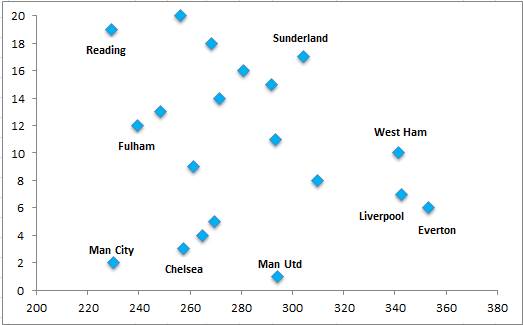
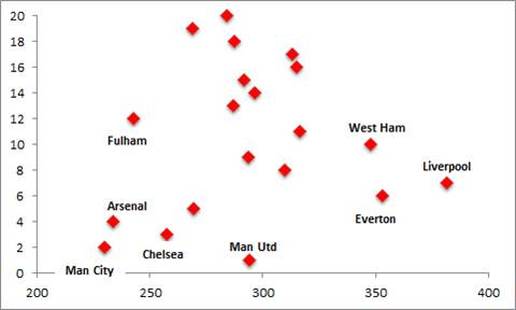
 RSS Feed
RSS Feed